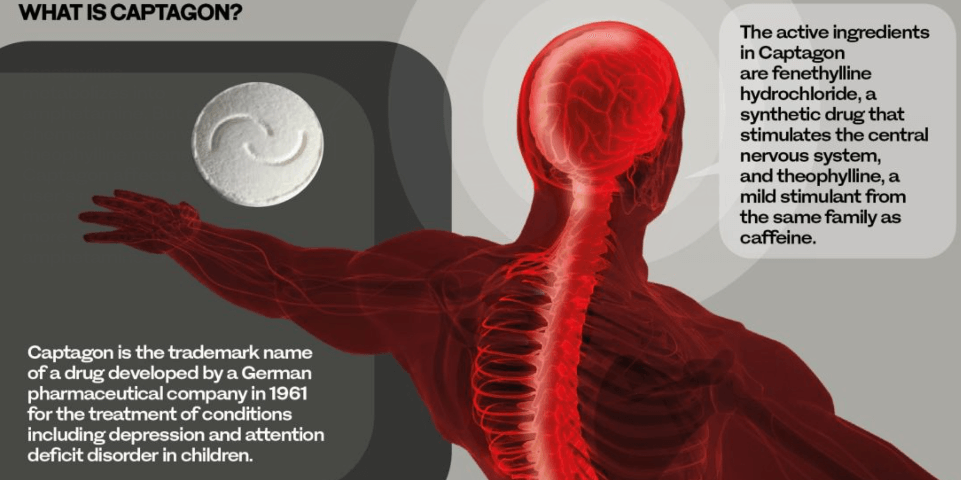What is Captagon? Unraveling the Dangers of a Highly Addictive Stimulant
Introduction
Captagon, a potent amphetamine-type stimulant (ATS), has emerged as a significant public health concern, particularly in the Middle East and North Africa (MENA) region.
Its widespread availability and popularity have raised alarms due to its highly addictive nature and severe adverse effects.
This paper delves into the intricate tapestry of Captagon, shedding light on its historical trajectory, mechanisms of action, multifaceted effects, detrimental impact on health and society, the ongoing efforts to combat its proliferation, and current scenarios and issues surrounding this illicit drug.
A Historical Perspective: Tracing the Origins of Captagon
Captagon’s origins trace back to the 1960s when German pharmaceutical company Degussa developed it as a treatment for narcolepsy, fatigue, and attention deficit hyperactivity disorder (ADHD).
Marketed under the brand name Captagon, the drug initially gained acceptance in the medical field.
However, concerns over its high potential for addiction and abuse led to its withdrawal from most markets in the 1980s.
The United Nations Convention on Psychotropic Substances, adopted in 1971, classified Captagon as a Schedule II substance, indicating its high potential for abuse but with some legitimate medical use.
Despite this classification, Captagon’s medical use was discontinued due to the emergence of safer and more effective alternatives.
Unveiling the Mechanisms of Action: Unraveling Captagon’s Impact on the Brain
Captagon’s psychoactive effects stem from its ability to mimic dopamine, a neurotransmitter that plays a crucial role in regulating mood, motivation, and reward.
By mimicking dopamine, Captagon floods the brain’s reward system, leading to a surge of euphoria, increased energy, and heightened alertness.
The drug’s primary targets include the dopamine transporter and the vesicular monoamine transporter, which are responsible for regulating dopamine levels in the brain.
Read More: Iron Sting Weapon System: A Comprehensive Overview
Captagon blocks these transporters, preventing the reuptake of dopamine and prolonging its exposure in the brain’s reward system.
A Multifaceted Spectrum of Effects: Exploring the Positive and Negative Consequences of Captagon Use
Captagon’s effects are multifaceted, encompassing both positive and negative consequences. On the positive side, users experience increased alertness, reduced fatigue, elevated mood, decreased appetite, and heightened confidence.
These effects can initially be appealing, particularly for individuals seeking enhanced performance or mood elevation.
However, Captagon’s negative effects far outweigh its perceived benefits. Users often experience anxiety, insomnia, restlessness, irritability, paranoia, and even psychosis.
Captagon’s addictive nature leads to physical and psychological dependence, with withdrawal symptoms such as fatigue, depression, irritability, anxiety, tremors, sweating, and cravings.
Unraveling the Dangers of Captagon: The Detrimental Impact on Health and Society
Captagon’s addictive potential and severe adverse effects pose significant health risks. Regular use can lead to heart problems, stroke, seizures, psychosis, and even death.
Moreover, Captagon use has been linked to increased aggression, violence, and criminal behavior.
In a study published in the journal “Addiction,” researchers found that Captagon use was associated with a fourfold increase in the risk of violence.
Another study, published in the “Journal of Forensic Sciences,” found that Captagon was detected in the urine of 50% of male homicide victims in Lebanon.
Combating Captagon’s Proliferation: A Multi-pronged Approach to Stemming the Tide
Recognizing the escalating threat of Captagon, international organizations, and governments have initiated various measures to curb its production, distribution, and use.
These efforts include:
- Strengthening border controls and drug trafficking interdiction efforts: International organizations like the United Nations Office on Drugs and Crime (UNODC) have collaborated with regional governments to enhance border security and disrupt drug trafficking routes.
- Disrupting illicit Captagon production facilities: Law enforcement agencies have conducted raids on illicit Captagon production facilities, confiscating large quantities of the drug and dismantling organized criminal networks.
- Raising public awareness about the dangers of Captagon: Public awareness campaigns have been launched to educate communities about the harmful effects of Captagon and discourage its use.
- Implementing comprehensive treatment and rehabilitation programs for Captagon addiction: Rehabilitation centers have been established to provide treatment and support for Captagon addicts, helping them overcome addiction and regain control of their lives.
Current Scenarios and Issues: Navigating the Evolving Captagon Landscape
Despite the ongoing efforts to combat Captagon’s proliferation, several challenges remain:
- The illicit nature of Captagon production and distribution: The clandestine nature of Captagon’s production and distribution makes it difficult to track and disrupt supply chains.
- The regional focus of Captagon’s consumption: Captagon’s primary market is concentrated in the MENA region, posing unique challenges for international cooperation and law enforcement efforts.
- The evolving nature of Captagon production methods: Captagon manufacturers are constantly adapting their methods to evade detection and produce the drug in smaller, more decentralized operations.
- The lack of adequate treatment facilities: The number of treatment facilities equipped to handle Captagon addiction is insufficient to meet the growing demand, particularly in conflict-affected areas.
- The social stigma associated with Captagon addiction: The stigma surrounding Captagon addiction discourages individuals from seeking help, hindering treatment efforts and perpetuating the cycle of addiction.
Emerging Trends and Future Considerations
As the Captagon landscape continues to evolve, several trends warrant attention:
- The increasing use of social media for Captagon sales: Online platforms are increasingly being used to sell and market Captagon, making it more accessible to a wider audience.
- The potential for Captagon to infiltrate new markets: Captagon’s availability and popularity could expand beyond its current regional focus, posing new challenges for global drug control efforts.
- The potential for Captagon use to exacerbate existing conflicts: Captagon’s stimulant effects and association with violence could further destabilize conflict-affected regions and heighten tensions.
To effectively address these challenges and emerging trends, a comprehensive approach is required:
- Enhanced international cooperation and intelligence sharing: Strengthening collaboration among law enforcement agencies and intelligence bodies can facilitate the identification and disruption of Captagon trafficking networks.
- Targeted awareness campaigns: Tailored awareness campaigns aimed at specific demographics and communities can help dispel misconceptions about Captagon and encourage individuals to seek help if needed.
- Expansion of treatment facilities and services: Increasing the availability of treatment centers and expanding access to specialized addiction services is crucial for addressing the growing demand for Captagon treatment.
- Addressing the root causes of Captagon use: Tackling underlying socioeconomic factors, such as poverty, unemployment, and social exclusion, can help reduce the vulnerability of individuals to Captagon addiction.
Sure, here are the future implications of Captagon’s proliferation with proper headings:
Future Implications of Captagon’s Proliferation
Increased Violence and Instability
- Captagon’s stimulant effects and association with aggression could further destabilize conflict-affected regions and heighten tensions.
- This could lead to increased violence, humanitarian crises, and displacement.
Public Health Crisis
- The widespread use of Captagon could exacerbate existing public health challenges in the MENA region, particularly among vulnerable populations.
- This could strain healthcare systems and lead to an increase in mental health problems, addiction-related deaths, and other health complications.
Economic Repercussions
- The illicit Captagon trade could have a detrimental impact on regional economies, diverting resources away from legitimate businesses and fostering criminal activities.
- This could hinder economic development and exacerbate poverty.
Potential for Captagon to Infiltrate New Markets
- As Captagon’s popularity grows within the MENA region, there is a risk of it infiltrating new markets, particularly in neighboring countries and regions with weaker border controls.
- This could expand the reach of Captagon and pose new challenges for global drug control efforts.
Evolving Production Methods and Trafficking Routes
- Captagon producers are constantly adapting their methods to evade detection and produce the drug in smaller, more decentralized operations.
- Additionally, trafficking routes could shift as law enforcement efforts intensify in certain areas.
- These changes could make it more difficult to disrupt Captagon supply chains.
Emerging Trends and Future Considerations
- Increased use of social media for Captagon sales
- Potential for Captagon to infiltrate new markets
- Potential for Captagon use to exacerbate existing conflicts
Call for Collective Action
- Strengthening international cooperation and intelligence sharing
- Investing in research and development
- Promoting public health interventions
- Addressing socioeconomic factors
- Adapting to evolving production methods and trafficking routes
Conclusion: What is Captagon?
Captagon’s pervasive use and detrimental impact on individuals and societies necessitate a concerted global response. By addressing the challenges and emerging trends associated with it, we can effectively stem its proliferation, mitigate its harmful effects, and foster a healthier and more secure future. The fight against Captagon requires collective action, encompassing international cooperation, targeted interventions, and a commitment to addressing the root causes of addiction. By working together, we can effectively combat this illicit drug`s proliferation and promote a world free from the destructive effects of this illicit drug.
Note: The information above might not be accepted 100%. Please verify from your own sources. We will not be responsible for any kind of loss due to our content.
For more news, please visit Munafa Marketing.




